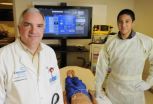(Press-News.org) A well-known paper-based medical chart used by pediatric emergency personnel across America is undergoing a 21st century boost in an collaborative effort between Virginia Tech's College of Engineering, Roanoke-based Carilion Clinic Children's Hospital, and the physician who created the original method some 25 years ago.
The Broselow Pediatric Emergency Tape – otherwise known as the Broselow Tape -- has been a staple of ERs and child trauma units for nearly three decades. Created by Hickory, N.C.-based physician James Broselow, the Broselow Tape is a long, durable tape measure used on a child during a medical emergency. Using a color coded-format, it provides specific medical instructions – amounts of medicines to dispense or level of shock voltage to emit from a defibrillator, for instance – to medical caregivers based on the height and then subsequent weight of the child.
This information now will be displayed on a large LCD monitor within emergency rooms, for all personnel to see.
"We are converting the existing Broselow Tape into an electronic format to improve resuscitation team communications and patient safety," said Andre A. Muelenaer Jr., an associate professor of pediatrics at the Virginia Tech Carilion School of Medicine, adjunct professor at Virginia Tech-Wake Forrest University School of Biomedical Engineering and Science (http://www.sbes.vt.edu/), and director of the Pediatric Medical Device Institute, located in Roanoke, Va.
Additional displayed information will include medicines administered to the patient, including the time of administration and the next scheduled allotment. In the instance of burns, an automated calculation of the affected surface area will be displayed, along with automated calculation of fluid resuscitation.
A click of a mouse/remote control can move responders from one screen to another. The software running the newly-dubbed eBroselow software program runs on LabVIEW, owned by National Instruments. Known as TEAM Broselow, the method is being tested at various hospitals, including facilities in Roanoke, Va., Austin, Texas, and Winston-Salem, N.C., and will be fine tuned as additional input comes in from doctors, nurses and other medical personnel, said Muelenaer.
Many of the new features already include input from medical personnel around the country, Muelenaer said. One example: The ability to track by barcode-scan the exact types and amounts of medicine administered to the patient. "The idea is to give multiple people access to the same info, on a big screen," said Al Wicks (http://www.me.vt.edu/people/faculty/wicks.html), an associate professor of mechanical engineering at Virginia Tech, who serves on the Pediatric Medical Device Institute's leadership team with Muelenaer.
Much of the work to digitize the Broselow Tape for display on LCD televisions was completed by Carlos Guevara, a Virginia Tech master's student in mechanical engineering from El Salvador who recently became an American citizen. Emergency medical personnel still will rely on the physical laminated tape to determine the child's care-need level, before utilizing the digital display version.
"Doing this was a rather simple task," said Guevara. "The challenges arose in an attempt to take advantage of current technology in order to develop a much more enhanced device, such as using the available drug concentration information to calculate volume to administer once a drug has been scanned."
The idea for a digital version of the Broselow Tape came two-fold, hundreds of miles apart. In Hickory, Broselow was working with a collaborator on a Web-based adaptation as far back as three years ago. Meanwhile, more than a year ago, Stacy Steans, a pediatric physician at Roanoke's Carilion Clinic Children's Hospital, had his own epiphany about converting the paper-based data to a wireless format displayed on a monitor. Eventually, Steans and Muelenaer at Carilion, the Virginia Tech College of Engineering and Broselow himself all came together to work on the process.
"We showed them what we had developed and they showed us what they had developed," said Broselow, who developed the tape after moving from a private practice set-up to emergency room, and seeing the need for large medical teams to have set standards for child emergency care response. "The initial content on the large screen was a combination of what their thinking was and the content information we had."
Funding for the project came from the Childress Institute for Pediatric Trauma. Rural hospitals, such as those located throughout Southwest Virginia, could benefit most from the software device, more so than urban hospitals with high-capita populations of children. "There are not as many children, so there are not as many cases," he said.
The tape itself is designed for children 12-years-old or younger, and having a maximum weight of roughly 80 pounds. Separately, Broselow and his company are continuing work on several digital formats for emergency rooms of all types and additional user formats such as iPhone applications and several publications, plus additional emergency response needs such as wounds sustained from chemical weapons.
INFORMATION:
Virginia Tech, Carilion team with physician to create digital ER pediatric response chart
2010-12-07
ELSE PRESS RELEASES FROM THIS DATE:
Warring Greeks find peace in ancient Egypt
2010-12-07
Tel Aviv ― Naukrtis, a Greek trade emporium on Egyptian soil, has long captured the imagination of archaeologists and historians. Not only is the presence of a Greek trading settlement in Egypt during the 7th and 6th century B.C.E. surprising, but the Greeks that lived there in harmony hailed from several Greek states which traditionally warred amongst themselves.
Dr. Alexander Fantalkin of Tel Aviv University's Department of Archaeology is delving deeper into this unique piece of ancient history to come up with a new explanation for how Naukrtis developed, and ...
Eutrophication makes toxic cyanobacteria more toxic
2010-12-07
Continued eutrophication of the Baltic Sea, combined with an ever thinner ozone layer, is favouring the toxic cyanobacterium Nodularia spumigena, reveals research from the University of Gothenburg, Sweden.
"There are several species of cyanobacteria, or blue-green algae, that can form surface blooms in the Baltic Sea," explains Malin Mohlin from the University of Gothenburg's Department of Marine Ecology. "Which species ends up dominating a bloom depends partly on how they deal with an increased amount of UV light and a shortage of nutrients. Nodularia spumigena is most ...
Exposure to mobile phones before and after birth linked to kids' behavioral problems
2010-12-07
Pregnant mums who regularly use mobile phones may be more likely to have kids with behavioural problems, particularly if those children start using mobile phones early themselves, suggests research published online in the Journal of Epidemiology and Community Health.
The researchers base their findings on more than 28,000 seven year olds and their mothers who were part of the Danish National Birth Cohort (DNBC) study.
This study enrolled nearly 100,000 pregnant women between 1996 and 2002, with the intention of tracking their kids' long term health.
The mums supplied ...
Ban electronic cigarettes until safety concerns are addressed, say researchers
2010-12-07
Regulatory authorities should consider banning electronic cigarettes until safety concerns have been addressed, concludes research published online in Tobacco Control.
The researchers base their conclusions on an evaluation of six different brands of electronic nicotine delivery systems or ENDS. These are not tobacco products, but are designed to look and feel like regular cigarettes.
They are aimed at smokers for use in places where cigarette smoking is not permitted as they don't produce smoke. They usually consist of a battery, an atomiser, and a replaceable cartridge ...
Flu vaccination disparities exacerbated by supply problems
2010-12-07
The gap in flu vaccination rates between elderly whites, African-Americans and Hispanics is amplified when vaccine supply is limited or delayed. That is the conclusion of a study out today in the American Journal of Preventive Medicine.
The study found that disparities in seasonal influenza vaccination rates between the groups grew by as much as 7 percentage points in years when there were problems with vaccine supply. By contrast, the gap narrowed by as much as 11 percentage points during years when the supply was more timely and abundant.
"There is a strong ...
Shy trout size it up
2010-12-07
Personality is not just a feature unique to humans and pets. Scientists at the University of Gothenburg (Sweden) have revealed that also brown trout have individual characters and show different personalities.
Researcher Bart Adriaenssens from the Department of Zoology at the University of Gothenburg has for many years studied the behaviour of juvenile trout from watercourses on the west coast of Sweden.
"My results show that it are not just humans and other mammals that exhibit personality. Also brown trout differ among each other in their level of aggression and react ...
2 studies provide insight into stroke risk and prevention in young sickle cell anemia patients
2010-12-07
Monthly blood transfusions combined with daily medication to remove the resulting excess iron remains the best approach for reducing the risk of recurrent strokes in young patients with sickle cell anemia, according to a preliminary analysis of a multicenter trial that includes St. Jude Children's Research Hospital.
The study compared the efficacy of two treatments for the potentially life-threatening problem of iron overload caused by chronic transfusion therapy. The transfusions are used to guard against additional strokes in young sickle cell anemia patients. The trial, ...
New tool in the early detection of bowel disease
2010-12-07
An international team of researchers led by the University of East Anglia (UEA) have developed a new kind of endoscope to aid the early detection and diagnosis of inflammatory bowel disease.
The Confocal Laser Endomicroscope (CLE) contains a powerful microscope which allows clinicians to view the bacteria that are thought to trigger diseases of the bowel such as Crohn's disease and ulcerative colitis.
"Bacteria within the wall of the gut are already believed to play an important role in the development of inflammatory bowel disease and we now have a powerful new tool ...
Researchers discover a way to delay Christmas tree needle loss
2010-12-07
Quebec City, December 6, 2010—Researchers at Université Laval, in collaboration with Nova Scotia Agricultural College, have discovered what causes Christmas tree needles to drop off, and how to double the lifespan of Christmas trees in homes. The authors presented their findings in a recent issue of the scientific journal Trees.
The researchers have identified a plant hormone—ethylene—responsible for needle loss in balsam fir. They made the discovery by placing fir branches in containers of water inside a growth chamber. After ten days the branches began to produce ethylene ...
Brand recognition can help hotels survive economic downturns
2010-12-07
Brand named hotels fare better than independently operated properties in economic downturns, according to a team of international researchers.
A study of the performance of hotels during both economic recessions and expansions indicates that brand named hotels are more profitable than independent hotels under all economic conditions, but the difference is particularly significant during recessions, said John O'Neill, associate professor of hospitality management, Penn State.
"There has been a lot of debate in the hotel industry about the advantages of brand affiliation ...



